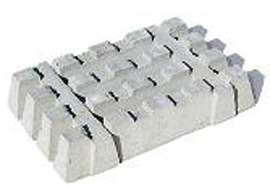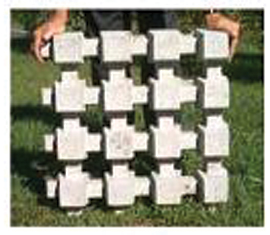



Feature Story
More feature stories by year:
2024
2023
2022
2021
2020
2019
2018
2017
2016
2015
2014
2013
2012
2011
2010
2009
2008
2007
2006
2005
2004
2003
2002
2001
2000
1999
1998
 Return to: 2011 Feature Stories
Return to: 2011 Feature Stories
CLIENT: MACTEC, Inc.
March/April 2011: Stormwater
The 2007 Energy Independence and Security Act (EISA) has raised the bar for managing stormwater at federal facilities. It requires preventing impacts and increased runoff for events up to and including the 95th percentile storm (2 inches, +/- 0.5-inch).
This criterion requires that predevelopment hydrology be maintained. This includes not only flow rate and volume, but flow duration and temperature as well. While we have recognized the need to go beyond controlling peak discharge rates and address increased volumes—and flow duration to some extent—the need to maintain temperature of runoff makes this a standard that requires knowledge of a broad range of planning and design techniques. This will require integrating low-impact development (LID) techniques, traditional structural stormwater designs (i.e., retention and infiltration facilities), and a sound understanding of hydrology, surface/groundwater behavior, and the nitrogen cycle.
 Beyond Federal
Beyond FederalThe criteria found in Section 438 of the EISA have also been used as examples for communities to adopt under EPA's 2010 MS4 Permit Improvement Guide. In that guidance document, which will have significant influence on current and newly added municipal separate storm sewer system (MS4s), one of the examples for the basis of performance standard is: "Design, construct, and maintain stormwater management practices that manage rainfall onsite, and prevent the offsite discharge of the precipitation from all rainfall events less than or equal to [insert standards, such as 'the 95th percentile rainfall event']. This objective must be accomplished by the use of practices that infiltrate, evapotranspire, and/or harvest and reuse rainwater."
Specific details are found in the technical guidance for Section 438 of the EISA, which discusses both new development and redevelopment scenarios and is another reason this is of interest for those who are (or will be) designated as an MS4 in 2013.
An in-depth review of storm depth retention criterion in the July/August 2010 issue of Stormwater ("Green Infrastructure and Storm Depth Retention Criteria") discussed in detail the value of continuous modeling. The article mentioned "maximum extent technically feasible" (METF) and analyzed the difficulties and complexities of, first, preventing offsite discharge from the 95th percentile storm event (Option 1 in Section 438), and, second, preserving the predevelopment runoff conditions (Option 2).
Option 1 can become difficult to address when the soils on the site do not allow for the needed rates of infiltration to address the added imperviousness. The potential for finding a reference site to address Option 2 was also identified as a clear hurdle to overcome if Option 1 was not beneficial to the process for a particular site. A key point in the article: when comparing site conditions (pre- and post-development), some things are absolute and some things are relative. Our objective is to protect when developing new sites and to restore when redeveloping in urbanized locations. And to do that, we need to have that broad, holistic view of the watershed and not just the site.
This is where another unnamed option was presented in Section 438: "…existing site conditions and uses of the site can influence the amount of runoff that can be managed onsite through infiltration, evapotransporation, and harvest and use, and thus the performance design objective."
Section 438 further states, "…fully restoring predevelopment hydrology can be difficult to achieve, and Congress recognized this potential difficulty by including the METF language in the statute."
But before you interpret this as a bailout clause, continue reading: The goal to provide increased standards for water-quality protection has not been circumvented by the METF.
For projects where technical infeasibility exists, there is a responsibility to make a clear and convincing case. It has to be documented, using the appropriate technical and economic assumptions and analyses. Site conditions and the applied (and appropriate) strategies need to be listed, along with the technical findings that quantify the extent to which the predevelopment hydrology can be restored. It is not expected that a single site condition can lead to infeasibility; therefore, a variety such as those listed below should be considered early for the purpose of successfully meeting the requirements of Section 438.
If you go into a project with the honest intention of identifying obstacles, for the purpose of resolving them, documenting infeasibility will not be difficult. In most cases, there will be something that can be done to reduce runoff, either by reducing imperviousness or increasing infiltration. More importantly, when you attempt to meet the highest standards, the site will avoid or minimize impacts for new development, and you will have the greatest potential improvement to water quality through redevelopment.
| Examples of alterna- tive pavements that can reduce runoff volume: |
|
| Concrete Paver Block |
 |
| Castellated Block |
 |
| Lattice Block |
 |
| Grass/ Gravel Paver Mat |
For those who fear that METF is a new loophole to be exploited and will undermine protecting water quality, here's one example.
When a state department of transportation decides that a smaller, lesser-used road that crosses a stream needs to be replaced, it aims high, applying standards for newer roads. For this quick example, say that a bridge needs to clear the water level of the 25-year storm event by 2 feet. But after assessing the site, recognizing that it was constructed long ago and that it is overtopped by the 1-year event, you find that it would take an extensive and very expensive bridge to meet that standard. So you find ways to keep that road above water, for a reasonable cost, for the 10-year event. The choices are a) No new road: We don't have, or can't justify, the money it takes to keep it high and dry for the 25-year event; or b) For a reasonable cost, we can ensure that part of town is not cut off from police and rescue services during a 10-year storm event.
One way to address such increased onsite retention requirements is to have runoff reduction as your central stormwater management tool, applied at the planning stages of a project. There is a relatively simple but logical and empowering method that has been presented by many people in the industry. Here is one framework, as outlined in the Coastal Stormwater Supplement to the Georgia Stormwater Manual, that makes it easier to address these increased retention requirements:

Framework for controlling runoff and costs
If you can embrace those ideas, not only can you address Section 438 more effectively, but you are now also an expert on the philosophy of LID. In short, the goal is to trick the ground into reducing and treating runoff with fewer design and construction efforts, which requires more planning.
More planning to incorporate LID or other strategies does increase planning costs. But planning is a relatively small portion of the total cost required to develop and construct a project. Therefore, if that increased planning effort reduces construction costs, as well as design and permitting efforts, you can expect a sound return on that early investment.
Let's simplify it: Do less, plan more, spend less. In some cases, what you will have constructed will have a "greener" look to it in the form of natural amenities, which may justify a higher sale or rental price. If there is less runoff, then less stormwater infrastructure is needed. And by reducing the runoff for smaller events (e.g., 1 to 2 inches) through various stormwater techniques, including LID, the peak runoff rates for large (50- and 100-year) events also are reduced.
Often we limit our discussions regarding water-quality standards to new development. And that makes sense—new development brings the potential for more runoff and pollutant loads, and there is more flexibility to plan and implement the proper controls. However, I think that it is very important to steer the discussion toward existing development, or redevelopment. It's always more challenging to restore the hydrology of redevelopment sites to predevelopment conditions. Such sites were initially developed prior to modern standards, many of which are much less stringent that what Section 438 requires. Furthermore, due to the lack of space and more intense development, they often are unable to balance the amount of imperviousness needed to allow the site to function with open space that can be used to infiltrate and retain runoff.
So why should we talk about these sites when it is hard enough to deal with the 95th percentile storm on a greenfields site? Four letters: M – E – T – F. The framework for showing that it may be infeasible to meet the full standard of protection for a new site is the same process used to identify how to get the greatest degree of improvement (or restoration) in water quality for an urbanized area. Let's keep new, greenfields sites healthy and strive to make relative reductions in the existing (pre-project) runoff and pollutant loads by applying better stormwater retention and treatment techniques to the maximum extent possible (i.e., technically feasible).
The concept of redevelopment is one that I go back to time and time again, whether I am providing consultation to towns and counties, providing LID seminars, or teaching water resources issues to my students at the University of North Florida. I believe that it offers the means to improve water quality in our urban areas—military and public. In these tough economic times, they are the right places to promote growth (in revenues and prosperity, not imperviousness). And this can be done without sacrificing the environment. Below are two brief discussions that illustrate the value of redevelopment using METF as the means to provide meaningful and affordable protection and improvement to our watersheds.
Incentives for Redevelopment. Offering incentives (including early concept development support and permitting assistance) can make it economically feasible for a developer to commit to redeveloping a site. Applying better site planning and design practices, even if the METF criterion is needed, will reduce the existing (developed) pollutant loads and runoff volumes. The added benefit is that increasing the rate of redevelopment in a community generates more revenue—which is the purpose of redevelopment. That increase to the general fund (or user fee) can support other programs that can contribute to improving or protecting water quality through offsite municipal projects and programs (pond repairs, improved drainage for roadways, preventative operations and maintenance, increased inspection and enforcement, etc.). If there is a stormwater user fee, then credits are usually made available so that the noted practices result in reductions in the annual user fee that applies to that site. An ongoing cash return is provided to the property owner to recuperate the initial investment, in return for an ongoing reduction in runoff and pollution to the watershed and community. Imagine this: a time in which urban areas have reduced their pollutant runoff volumes and pollutant loads by 10 to 20% without the need for public funding, while local revenues increase.
Watershed Improvement and Private Retrofitting. Communities with threatened or impaired water quality spend significant effort (and cost) identifying and assessing sources of stormwater impacts. A common practice is to identify existing water features and undeveloped parcels to retrofit—often by creating retention/detention features that reduce or treat runoff from the previously developed portions of the watershed. Retrofitting is expensive and often impossible due to lack of public support. Imagine this: the public (in the form of a developer) presents the opportunity to reduce runoff and pollutant loads at the source, without encroaching on other property, with reduced expense by the community. Some of you may have seen this type of concept before, but led by the local entity with significant implementation costs, possibly as part of strategies to address total daily maximum loads.
Few, if any, individual techniques can solve all of your problems. Ponds, infiltration, bioretention, biofiltration, and similar techniques should not be viewed as pollutant-killing silver bullets, or a technical cure-alls to get over that regulatory hurdle.
Instead, you might want to take the Swiss Army knife approach: That handy little gadget is less costly than carrying around the entire toolbox, and although it is not a perfect tool, it is a real lifesaver when you are in trouble. Instead of finding ways to avoid resolving stormwater management issues that impact the environment, we need to encourage tougher standards and adapt new permitting processes and guidance to find solutions.
Return to: 2011 Feature Stories